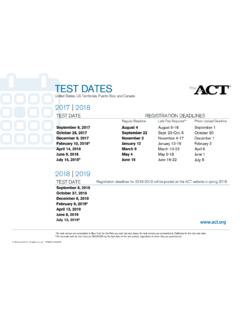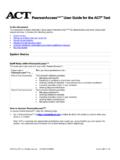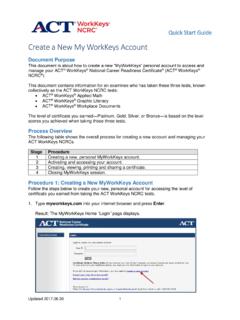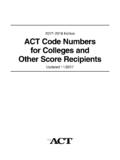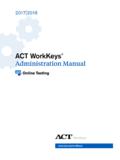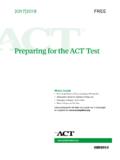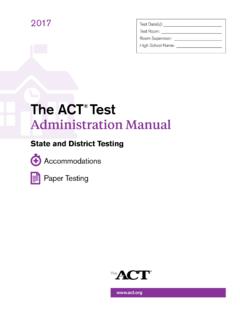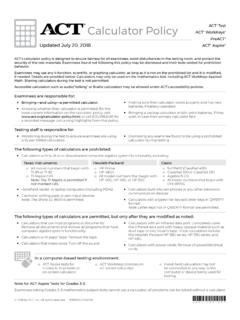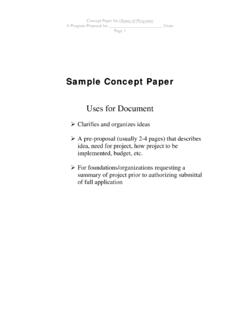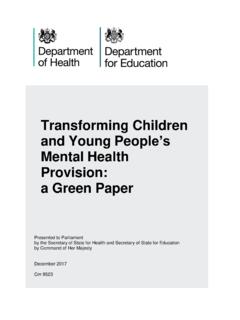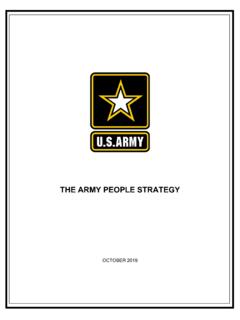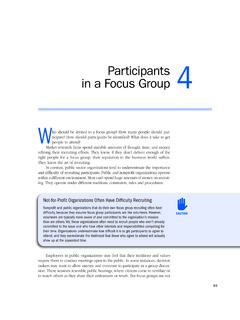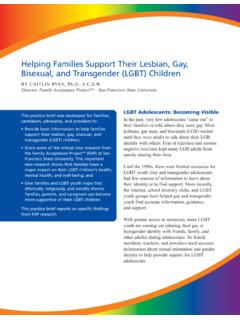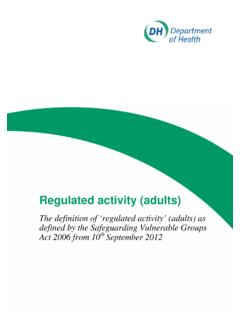Transcription of The Condition of Future Educators 2015 - ACT
1 The Condition of Future Educators 2015 NationalThe Condition of Future Educators 2015 ACT has conducted groundbreaking research on college and career readiness since its founding in 1959. Over the past decade in particular, ACT research has provided data and information guiding some of the nation s most important education and workforce issues and related initiatives. Each August, we release The Condition of College & Career Readiness ( ), our annual report on the achievement of the ACT -tested graduating class relative to college 2015, a record 59% of the US graduating class took the ACT test. The steady increase in ACT test takers in recent years has enhanced the breadth and depth of our data pool, providing a more comprehensive picture of the college readiness levels of the graduating class while giving us a deeper look into the data.
2 Our data review from this year s graduating class has offered a glimpse into new areas of study, including emerging educational this report, ACT looks specifically at students expressing an interest in education as a profession. ACT-defined education majors are categorized into four areas: Administration/Student Services non-teaching education majors, such as counseling, curriculum, and administration Teacher Education, General a single major considered by individuals who have an interest in teaching but have not yet determined a student population and/or subject area focus Teacher Education, Specific Student Population majors defined by the type of student being served, such as early childhood education and postsecondary education Teacher Education, Subject Specific majors defined by the type of subject taught, such as art education, foreign languages.
3 And mathematics educationOur Commitment to EducatorsACT conducts its exclusive ACT National Curriculum Survey every three to five years, surveying thousands of elementary, secondary, and postsecondary instructors to keep abreast of the specific skills and knowledge taught in America s schools and expected of first-year college students. We use these empirical data to inform the ACT College and Career Readiness Standards, which align with our assessments. These standards help ACT to give students, Educators , schools, and states the insights they need to determine whether students are on track for college and career readiness and to help improve educational Support and Development ACT s Call to ActionDevelop robust teacher evaluation systems.
4 Efforts to safeguard and use data appropriately and to fully align the education system are moot if we do not invest in one of the most important components of student learning: teachers. As stated in our K 12 education platform, ACT applauds states and districts development and use of robust teacher evaluation systems that include multiple measures of performance to identify effective teaching and focus on professional development. All teacher evaluations should include classroom observations, parent and student surveys, and measures of student growth on assessments. Teachers should be involved in the creation and rollout of these admissions criteria for teacher education programs and offer professional development to new teachers.
5 We must ensure that the admissions criteria for teacher education programs are rigorous and produce high-quality candidates armed with the tools sound instructional methods, content mastery, and data literacy to teach effectively. Once in the classroom, teachers must have the opportunity to participate in professional development opportunities that enhance their teacher compensation. Given that teachers are the most important school-based factor in student achievement, if we truly want the best teaching force in the world, teachers must be compensated correspondingly. Doing so demonstrates investment not only in teachers, but in students as is time to take these and other meaningful steps to solve the issues hindering student success.
6 ACT sincerely hopes that this call to action, informed by decades of educational research, contributes to the enhancement of education and career opportunities for all students, including our nation s most underserved individuals. ACT stands ready to work with like-minded organizations to support systemic education reforms. Ensuring a world-class US educational system should be a responsibility shared by all of us: Our Future rests on the education of tomorrow s leaders. We must do research (Using Dual Enrollment, 2015) demonstrates that education leaders are looking to dual credit classes and concurrent enrollment to ease the transition to college coursework.
7 Shortening the amount of time students spend working toward a postsecondary credential can reduce their total college cost, which is highly desirable to students, their parents, and policymakers. Critically, both of these factors disproportionately affect students from low-income families and/or first-generation college students. Certifying high school teachers for dual enrollment programs is valuable not only because it can advance a more rigorous high school curriculum, but also because of the positive influence certification can exert on the teachers non-collegiate courses. Dual enrollment programs can also potentially reduce the gap between high school teachers perception of college readiness of their high school graduates and college instructors perception of the readiness of their incoming first-year research (Use of Data to Support Teaching and Learning: A Case Study of Two School Districts, 2015) also shows the positive nature of the intersection between quality assessment and teaching.
8 ACT can provide data and insights to help new and existing teachers better understand how to use assessment data to inform goal of this report is to provide current Educators and policymakers a glimpse inside the pipeline of Future Educators . If the United States hopes to reclaim its perch as the world s leader in education, we must first address some of the key findings highlighted in this report. 2016 by ACT, Inc. All rights reserved. The ACT test is a registered trademark of ACT, Inc., in the USA and other countries. The ACT National Curriculum Survey is a registered trademark of ACT, Inc. 5 8 412 THE Condition OF Future Educators 2015 Key Findings from the National Condition of Future Educators 2015 Report1.
9 Interest among ACT-tested graduates in becoming Educators continues to decline at an alarming rate. Five-year trends indicate that of the more than million students who took the ACT in 2015, fewer than 88,000 students indicated an interest in education majors or professions. In the areas of math and science education, the numbers are even more concerning, with fewer than 3,700 indicating an interest in these combined with the fact that a teacher shortage already exists in many states and subject areas, these figures are very sobering. According to the National Center for Education Statistics, the total number of elementary and secondary school teaching positions needed in the United States is projected to increase by 14% between 2010 and 2021.
10 Coupled with the expected retirement of many baby boomer Educators , the fact that fewer students are interested in becoming Educators will likely magnify the teacher continues to validate the critical role of quality teaching in student success. However, quantity is also important: The nation must fill the pipeline to alleviate the expected shortfall in the number of available teachers. Our inability to do so will force educational systems to think differently about how we deliver education which might, in turn, have a negative impact on student Students interested in education have lower-than-average achievement levels, particularly in STEM areas.
